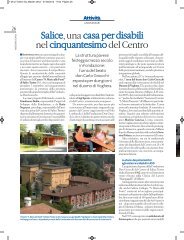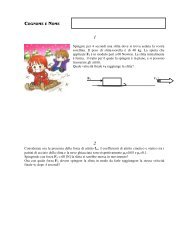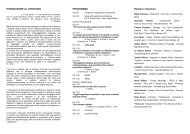Spingete per 4 secondi una slitta dove si trova seduta la vostra ...
Spingete per 4 secondi una slitta dove si trova seduta la vostra ...
Spingete per 4 secondi una slitta dove si trova seduta la vostra ...
Create successful ePaper yourself
Turn your PDF publications into a flip-book with our unique Google optimized e-Paper software.
Con<strong>si</strong>derate ora <strong>la</strong> presenza del<strong>la</strong> forza di attrito fatt. I coefficienti di attrito cinetico e statico tra i<br />
pattini di acciaio del<strong>la</strong> <strong>slitta</strong> e <strong>la</strong> neve ghiacciata sono rispettivamente µk=0.05 e µs=0.1.<br />
Spingendo con forza FS = 60 [N] <strong>la</strong> <strong>slitta</strong> <strong>si</strong> sarebbe messa in movimento?<br />
Ora con quale forza FS <strong>dove</strong>te spingere <strong>la</strong> <strong>slitta</strong> in modo da farle raggiungere <strong>la</strong> stessa velocità<br />
finale vF dopo 4 <strong>secondi</strong>?<br />
Se <strong>la</strong> <strong>slitta</strong> fosse ferma, <strong>per</strong> il I° principio del<strong>la</strong> statica <strong>la</strong> risultante di tutte le forze che agiscono su<br />
di essa R è =0.<br />
Sul<strong>la</strong> <strong>slitta</strong> agisce:<br />
1. il peso P;<br />
2. <strong>la</strong> reazione vinco<strong>la</strong>re N del<strong>la</strong> neve sui pattini, uguale ed opposta a P: N=-P<br />
3. <strong>la</strong> spinta FS;<br />
4. <strong>la</strong> forza di attrito statico fatt S<br />
FS<br />
fatt S<br />
Se con<strong>si</strong>deriamo che <strong>la</strong> componente orizzontale di R deve essere uguale a 0, deve verificar<strong>si</strong> <strong>la</strong><br />
condizione:<br />
fatt S = -FS<br />
Il modulo del<strong>la</strong> mas<strong>si</strong>ma forza di attrito statica ammis<strong>si</strong>bile è dato dal<strong>la</strong> formu<strong>la</strong>:<br />
| fatt S MAX |= µs |N|<br />
poiché |N|= |P|=mg=40x9.8=392 [N]<br />
| fatt S MAX |=0.1 x 392=39.2 [N]<br />
Ma FS=60 [N] è maggiore del<strong>la</strong> mas<strong>si</strong>ma forza di attrito statico pos<strong>si</strong>bile, quindi <strong>la</strong> <strong>slitta</strong> non può<br />
rimanere in equilibrio, ma <strong>si</strong> mette in movimento.<br />
Durante il moto, <strong>la</strong> forza di attrito che agisce sul<strong>la</strong> <strong>slitta</strong> è l’attrito dinamico fatt K di valore:<br />
fatt K =µk |N|=0.05 x 392=19.6 [N]<br />
La componente orizzontale del<strong>la</strong> risultante R delle forze che agiscono sul<strong>la</strong> <strong>slitta</strong> è:<br />
Rx=|FS| -| fatt K |=60-19.6=39.4 [N]<br />
Poiché Rx =ma, questa risultante accelera <strong>la</strong> <strong>slitta</strong> del<strong>la</strong> quantità a=39.4/40= 0.985 m/s 2<br />
e l’accelerazione è minore rispetto al caso senza attrito.<br />
Perché <strong>si</strong> abbia <strong>la</strong> stessa accelerazione di prima (e <strong>si</strong> raggiunga quindi <strong>la</strong> stessa velocità finale) , sarà<br />
necessario applicare <strong>una</strong> forza maggiore, FS ’ , in modo che <strong>la</strong> risultante <strong>si</strong>a ancora pari a 60 [N]<br />
|FS ’ | -| fatt K |=60<br />
|FS ’ | -19.6=60<br />
|FS ’ | =79.6<br />
P<br />
N
















